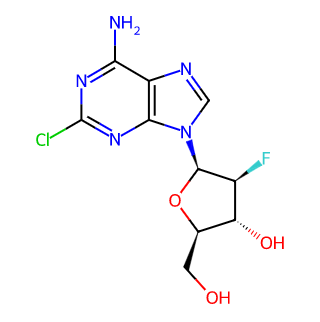- Synthetic anti-infective drugs
- Medications for the digestive system
- Antipyretic and analgesic drugs
- Medications for the blood system
- Medications for the respiratory system
- Anti-allergic drugs
- Medications for the urinary system
- Diagnostic medications
- Immunosuppressive and immunomodulatory drugs
- Vitamins and mineral supplements
- Antioxidants and medications for osteoporosis
- Antiparasitic drugs
- Ophthalmic medications
- Amino acids and their derivatives
- Dermatological medications
- Medications for the circulatory system
- Antitumor drugs
- Medications for the nervous system
- Hormonal and endocrine function-regulating drugs
- Antibiotics
- Others
CAS Number: 123318-82-1




Basic Information
Product Name: Clofarabine
CAS Number: 123318-82-1
Molecular Formula: C10H11ClFN5O3
Molecular Weight: 303.68
Appearance: White powder
Physical Properties
Melting Point: 228~231°C
Boiling Point: 550.0±60.0°C (predicted)
Density: 1.4804 (estimated), alternatively given as 2.12g/cm³
Solubility: Soluble in dimethyl sulfoxide (DMSO) >10mg/mL
pKa: 12.56±0.70 (predicted)
λmax: 263nm (EtOH)
Chemical and Biological Properties
Chemical Class: Nucleotide analogue, second-generation purine nucleoside analogue
Mechanism of Action: Combines the advantages of fludarabine and cladribine, inhibiting both DNA polymerase and ribonucleotide reductase.
Biological Activity: Exhibits anticancer activity and induces apoptosis. In various leukemic and solid tumor cell lines, Clofarabine demonstrates strong growth inhibitory and cytotoxic effects in vitro.
Pharmaceutical Characteristics
Indications: Currently the only drug suitable for the treatment of pediatric leukemia and specifically for pediatric acute lymphocytic leukemia (ALL).
Dosage and Administration: Can be administered intravenously or orally. Specific dosage and administration should be determined based on patient condition and medical guidance.
Adverse Reactions: May include hematological reactions such as leukopenia, neutropenia, thrombocytopenia, and anemia; digestive system reactions such as anorexia, nausea, and vomiting; neurological reactions such as fatigue, drowsiness, and headache; cardiovascular reactions such as tachycardia and hypertension; as well as potential liver toxicity, respiratory distress, hematuria, and other adverse reactions.

Tai Yau Street, San Po Kong, Kowloon, Hong Kong, China.



